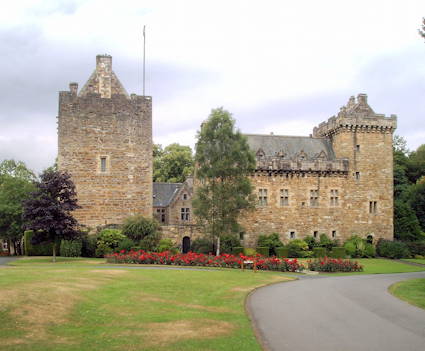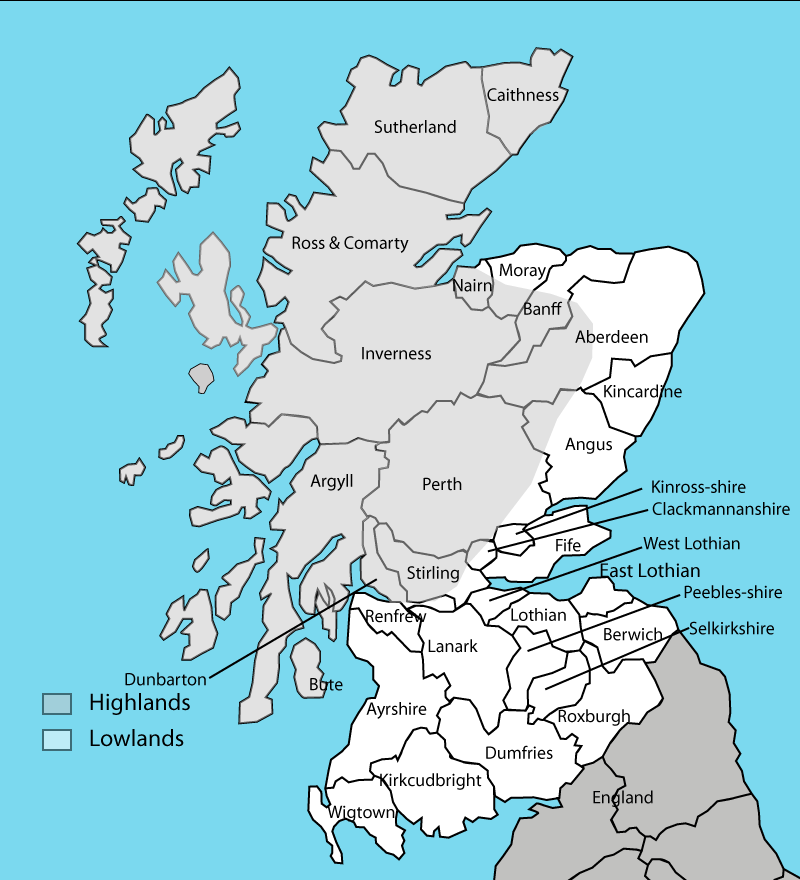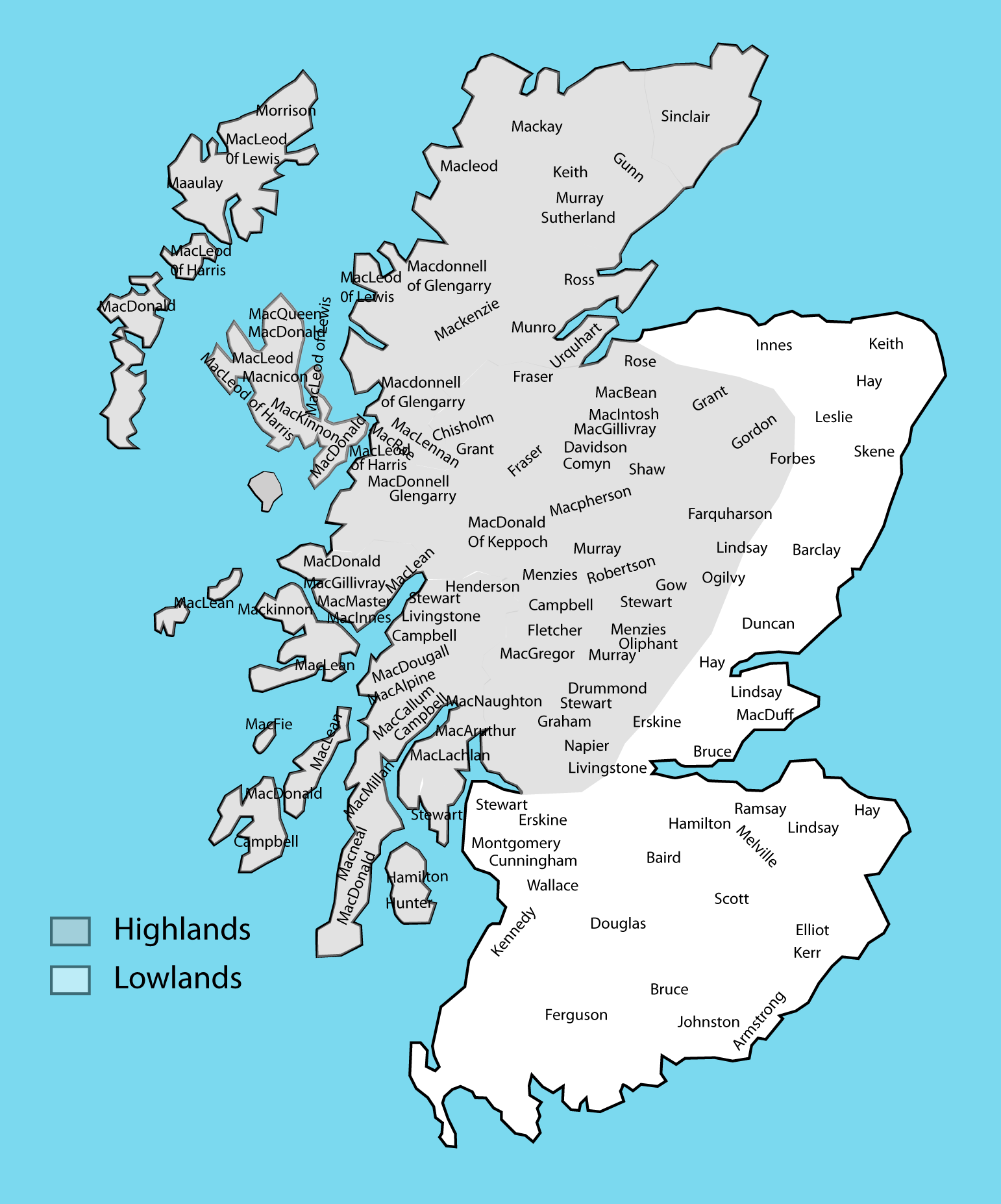Protestant Reformation in Scotland
The Scot Lowlander
Reasons for migration
Origin of the Boyds
Clans
Scots Irish
Many Scots Lowlanders settled in Northern Ireland during the 17th Century where they were known as Ulster Scots. Beginning in the 1700's many of these Ulster Scots moved to America, where they were known as Scots Irish and made significant contributions to the development of the new nation. In this page and the Ireland page, I will outline the history of the Scots Irish and the reason for their migration to Ireland, the American Colonies and the American frontier.
A Brief History of the Boyd's in Scotland
Although it is unlikely that we are directly descended from them, the Boyd family was a member of the Scottish nobility. Although unassociated with Kilmarnock since 1748, the Boyds have at various times been either the Baron Kilmarnock or Lord Kilmarnock. I'll attempt a very brief history of the Boyds of Scotland. This is not a comprehensive history, but just a few points of reference that trace the main events over time.
The Boyds first appear in history as vassals of the Norman family de Morvilles. Richard de Morville was the Lord of Cunninghame and Constable of Scotland. Robert Boyd was a witness to a contract in Irvine, Ayrshire in 1205.
In 1314, Sir Robert Boyd, a supporter of Robert the Bruce (King of Scotland 1306 - 1329) was the commander at the Battle of Bannockburn and as a reward for his military service, Robert the Bruce granted him the Barony of Kilmarnock and lands of Bondington and Hertschaw. In 1454 Sir Robert was raised to the peerage by King James II and became the first Lord Boyd.
From 1466 to 1469, Robert, Lord Boyd was the Regent of Scotland while James III was a minor. However, he fell from favor and was convicted of treason and sentenced to death in 1469. Although he escaped to England, he had to forfeit all his lands and title. The Lordship & Barony of Kilmarnock was granted to Queen Margaret Tudor, wife of King James IV, in 1504.
View Larger Map
The Boyds returned to favor during the reign of Mary, Queen of Scots, and Lord Boyd was restored to the peerage in 1545. In 1661, the 10th Lord Boyd was made Earl of Kilmarnock by Charles II. However, William, the 4th Earl of Kilmarnock, supported the Jacobites and was executed in London after the battle of Culloden in 1746. As a result his title was forfeited. His son, however, became the Earl of Erroll, through his mother and took the surname Hay.
Sir William George Hay, 18th Earl of Erroll was created 1st Baron Kilmarnock, of Kilmarnock, Ayrshire [UK] on 17 June 1831. In 1941, Josslyn Victor Hay, the 22nd Earl of Erroll and 5th Baron Kilmarnock died leaving no male heir and his brother, Gilbert Allan Rowland Hay became the 6th Baron Kilmarnock. In 1941 he changed his surname to Boyd. His son, Alastair Ivor Gilbert Boyd, born on 11 May 1927 is the current 7th Baron Kilmarnock.

Dean Castle in Kilmarnock was the home of the Boyds for about 400 years, the initial structure being built around 1350. in 1467 when he was elevated to the peerage, Robert built a palace as an addition to the existing defensive Keep. During the period from 1503 to 1545, after Robert, Lord Boyd was convicted of treason and stripped of his lands and title, the lands and castle were leased to the Boyds. The Boyds regained possession of Dean Castle in 1661 when Charles restored his title. The Palace was accidentally burned in 1735 and subsequently abandoned for 200 years. Today it is a museum and park.
A complete genealogy of the Boyds of Kilmarnock can be found here.
__________________*Permission is granted to copy, distribute and/or modify this document under the terms of the GNU Free Documentation License, Version 1.2 or any later version published by the Free Software Foundation; with no Invariant Sections, no Front-Cover Texts, and no Back-Cover Texts. A copy of the license is included in the section entitled "GNU Free Documentation License".
Scotland in 1600
In 1600 Scotland was still essentially medieval. It seems to have missed the renaissance almost entirely (or at least until the 18th century). Although the Catholic Church had founded 3 universities (At. Andrews in 1411, Glasgow in 1451 and Aberdeen in 1494) they were completely devoted to the education of the clergy. There was essentially no intellectual class before 1600. There was no national law. All justice was local justice administered by the Lords and Lairds. However, the reciprocal loyalty that held the Scottish feudal system together resulted in a generally fair execution of the justice. For this, the Lords and Lairds are to be commended. The Protestant Reformation was the catalyst that would change Scotland, create a nation and provide the basis for the character of the Scots Irish.
Scotland as a whole is about the size of South Carolina. The Highlands in the north and west comprise over 60% of Scotland and is a very rugged territory containing many isolated or inaccessible valleys. The Highland soil is of such poor quality that farming is almost impossible. In 1600, the people of the Highlands could most kindly be described as uncivilized.
The Lowlands are the area south of Glasgow including the coastal area north of Edinburgh, towards Aberdeen. The land, although better suited to farming than the Highlands, was still poor and by 1600 had been largely deforested. In 1600, most of the people and all of the towns were in the Lowlands. "Every royal burgh in old Scotland, like practically every modern city, was within ten miles of the sea.1
The social structure of 16th century Scotland Lowlands consisted of 3 classes:
- Noblemen or Lords, were the landowners and essentially ruled as monarchs
- Gentry, burghers in the towns and lairds (squires) in the countryside (the middle-class)
- Tenants, who were the actual farmers (serfs)
Feudalism in Scotland, probably influenced by the earlier clan organization, was characterized by a strong sense of loyalty both by the tenants toward to Lord as well as by the Lord toward the tenants. The Lords defended the rights and "property" of their tenants and lairds. The tenants' relationship to the Lord preserved his own individuality and therefore he maintained a sense that his own strength and abilities mattered. Humility was not a characteristic of the lowland farmer in 16th century Scotland. The laird maintained loyalty by proving himself deserving of that loyalty through leadership and protection of the tenants.
In contrast, the Highlands had no real social structure except the clan, which is a large family ruled by a chief who is no different than other members in class. There was no real Noble class or middle class (gentry).
Life was very harsh for the lowland farmer. The soil was poor, farming methods were primitive, the weather was harsh. There were frequent plagues, almost constant wars and internal violence, feuding and general lawlessness in between the wars. The tenant farmers owed military service to the Lord and were frequently called away from the farm to fight as soldiers. The area along the border with England was subject to frequent military raids from the English and retaliatory raids into England by the Scottish. A general lack of education, isolation from other countries, and superstition prevented the lowland farmer and the society in general from improvement and advances.
In spite of their harsh life, the lowland farmers participated in a generally cheerful society. Music and folk tales were an important part of the culture. Even so, emigration was common. Many young Scots went to Europe to seek their fortune either as soldiers or merchants. The Scots were known as a people with a disposition toward wandering and adventure. It was these lowland Scots farmers who would emigrate to Ulster and become the Ulster Scots or Scots Irish and play a significant role in the development of the United States.
_________________________
1 James G. Leyburn, The Scotch-Irish; A Social History, The University of North Carolina Press, May 1962, p. 3
The Protestant Reformation in Scotland
By 1560, the Catholic Church in Scotland had accumulated almost one third of the land and nearly half of the wealth of the county. It was corrupt, ineffective and as a result of the general isolation of Scotland, had not had the influence of the many movements that had affected the Church in Europe. There were no Scottish saints and no Scottish religious scholars. Rome was too remote or maybe too uninterested to abate the laxity and corruptness of the Scottish Clergy. Besides the general dissatisfaction with the Church, there were also political and economic factors that supported the Reformation in Scotland. The king was aligned with the church. The noblemen saw reformation as a way to enhance their power as well as their wealth. For two centuries Scotland had had an alliance with France and was frequently at war with England. However, many Lords favored aligning with England because of its proximity and because Scotland had fallen behind England in population, industry, trade, wealth and power. In a continued battle with England, Scotland was sure to lose. Since England, at the time, was protestant, this added additional reason for the Lords to support reformation.
The stage was set when an anonymous scholar left the Beggars' Summons on the gates of every religious establishment in Scotland on New Years' Day, 1559. The manifesto written in the name of the "blind, crooked, lame, widows, orphans and all other poor" and was addressed to all friars within the country, demanded restitution for past wrongs. It demanded that the friars be evicted and that their property be returned to the rightful owners, the poor. On May 4th, probably incited to action by a fiery sermon delivered by John Knox, a riot broke out in Perth and the religious houses and church were looted. The result was a war in which the Queen Regent (Mary of Guise) recruited a French army and marched on Perth. It was a short war and was over by the summer of 1560.
On July 10 1560, the Scottish Parliament passed three laws:
- Formally ended the Scottish Church's relationship with Rome
- Condemned all doctrines and practices contrary to the Protestant Church of Scotland
- Outlawed the saying of Mass
The Presbyterian Church was established as the Kirk of Scotland (kirk means church and the Kirk is the official Church of Scotland). Overall, the reformation in Scotland was more peaceful than in any other country in Europe. The new church had a profound impact on the people of Scotland. The Presbyterian ministers lead exemplary lives, devoting themselves to their pastoral duties. This won the respect and support of the people. One of the goals of the church was to eliminate illiteracy, and they established schools which resulted in the people developing a devotion to education. The second main goal of the Presbyterian church was to reform the morals of the people, which it did all too effectively. The Presbyterians became Puritanical and intolerant. Persecution of witches was common, and the practice of any other religion was not allowed. (In this regard, the Presbyterians were somewhat more tolerant the the Catholics had been. Whereas the Catholic church often punished heretics by death, the Presbyterians merely imprisoned them.)
However, the Presbyterian Church did introduce the people of Scotland to the concept of democracy, although limited. The local parish was self governing. The Session was the governing body in the local parish and both laymen (including tenants) and clergy participated. The Session sent representatives to the regional Presbytery and the regional Presbytery sent representatives to the national Assembly. The result was that laymen felt both a right and a duty to express themselves on issues both local and national. The Calvinistic theology granted the individual primary importance.
The Scot Lowlander
There is no general agreement regarding the ethic origins of the Scots Irish. Many have suggested that they are descendents of the Picts, Caledonians and other early inhabitants of Scotland, or that there was a vast celtic empire extending over much of Europe. There is very little tangible evidence to support this theory and the Celtics were probably confined to Western Europe (Western parts of England and Scotland, Ireland, western British Islands, Brittany and western France). The association of the Scots Irish with the Picts is uncertain since the origins of the Picts are also not well understood. The Picts were probably just one of the Celtic tribes, most likely the ancestors of the Scots Highlanders. Much has been made of the conflict between the Scots Lowlanders and the English just across the border. However, there is probably no ethnic difference between the Lowlanders and their neighbors across the border in England. They spoke the same language (Early English). There is no topological border that would lead to development of separate cultures and the distinction between Scotland and England at that point is probably more a matter of historical accident than conflicting cultures. Indeed, many of the emigrants to Ulster that would later be called the Scots Irish were in fact from the northern border regions of England. Scots Irish descendents in America today like to associate themselves with the Scottish clan traditions, but the Scots lowlanders were quite different from the Highlanders.
The Scottish lowlander was shaped by centuries of conflict and hardship, religion, and the unique reciprocal loyalty that existed between the common people and the Nobility. Although subservient to the nobility under the feudal system, he was never humble and believed in the equality of men, freedom (as he understood it) and that a man's rights are worth fighting for. The Presbyterians instilled a zeal for leaning, but only for the purpose of furthering his religious understanding. Education was strictly for the purpose of training ministers or teachers, and the Universities taught primarily theology and dialectic. The Bible was all knowledge and other learning was not needed. Even after the Reformation, there was a complete lack of art in Scotland.
Henry James Ford describes the character of the Scottish Lowlander as possessing
"an economy and even parsimony of words, which does not always betoken a poverty of ideas; an insuperable dislike to wear his heart upon his sleeve, or make a display of the deeper and more tender feelings of his nature; a quiet and undemonstrative deportment which may have a great firmness and determination behind it; a dour exterior which may cover a really genial disposition and kindly heart; much caution, wariness, and reserve, but a decision, energy of character, and tenacity of purpose, which as in the case of Enoch Arden, 'hold his will and bear it through;' a very decided practical faculty which has an eye on the main chance, but which may coexist with a deep-lying fund of sentiment; a capacity for hard work and close application to business, which, with thrift and patient persistence, is apt to bear fruit in considerable success; in short, a reserve of strength, self-reliance, courage, and endurance which, when an emergency demands (as behind the Walls of Derry), may surprise the world."2
_________________________
2 Henry James Ford, The Scotch-Irish in America, Princeton University Press, Princeton, NJ, 1915; reprint, Arno Press and the New York Times, New York, 1969,
p. 575
The Reasons for the Scottish Migration to Ireland
During the 17th century, between 1605 and 1690, large numbers of Scottish lowlanders emigrated to Ulster in Northern Ireland. King James I of England sought to pacify the Irish by "planting" protestant English and Scottish settlers in Ireland beginning in the early part of the 17th century (see Ulster Plantation). The most successful efforts were carried out with settlers from the Scottish lowlands, who had both economic and religious reasons for emigrating to Ulster in large numbers. The economic reasons were dominant for the first 50 years and religion was the dominant reason for the next 30 years.
As described above, life was difficult enough in Scotland, but beginning with the introduction of the feu in the mid 16th century there were additional economic hardships. The feu is a feudal arrangement for leasing land. Unlike the traditional feudal arrangement in which the tenant gets the right to farm the land in return for service (both labor and military) and a share of the crop to the laird or landowner, the feu was a simple lease for money in which the tenant paid a fixed amount of rent. There was no obligation of service and the lease would last as long as the tenant continued to pay the rent. This was good for the landowner, because if provided a steady income, and the rents were usually higher. However, the result was that generally the lands were leased to the wealthier lairds who could afford the higher leases and the traditional tenants lost the lands that they had been farming for generations. These dispossessed tenants became either subtenants or laborers with a resultant loss of income and status. The Ulster Plantation, beginning in 1606, was an attractive opportunity for these dispossessed farmers. Ulster offered:
- Better land, more fertile and productive than any available in Scotland.
- Safety. The planters were to be protected by the English army-an attractive alternative to the decades of war with the English.
- The promise of peace and law
It was also close. Ireland is only about 15 miles away at its closest point, making the journey easy. (Note the plantation of Ireland occurred contemporaneously with the Jamestown settle in Virginia. Clearly, the journey from Scotland to Ireland was much easier than the trip across the Atlantic to Virginia.)
The religious impetus for migration began around 1660. From the beginning of the Protestant Reformation in Scotland there was a controversy over the form of government for the Church, which can be described as Presbyterianism vs. Episcopacy. The Presbyterian position was that all ministers were equal and the hierarchy of the ruling organization in the church was largely democratic (the local church is governed by the Session, made up of members of the congregation; the session sends representative to the Presbytery which in turn sends representative to the National Assembly). In contrast, the Episcopacy has permanently appointed Bishops. It should be noted that the controversy is over the governance of the church, not theology. For the first 30 or 40 years, the Presbyterians more or less prevailed. James VI was raised as a protestant (although his mother was catholic) and generally accepted that the Protestant church was good for Scotland in that it made the people easier to govern. However, he was concerned that the democratic nature and free speech of the General Assembly of the Presbyterian Church would undermine the authority of the crown and therefore sought to introduce a more Anglican version of the church. This continued with his successor, Charles I. The opposition to the Crown was led by a group called the Covenanters, who, in 1638, signed a covenant committing themselves to maintain the form of worship and government of the Kirk of Scotland.
When Charles II was restored to the Throne in 1660 following the Civil War, the Covenanters essentially waged a guerrilla war against Charles and his efforts to Anglicize the Scottish Church. Referred to as the "killing time" it was a bloody and ruthless conflict. In contrast, there was general freedom of worship in Ulster and the Presbyterian's there had none of these problems, providing another incentive for the Scots Lowlanders to emigrate. The conflict over the church finally ended when William II (William III of England) assumed the throne in 1689 and gave the Scots their religious freedom.
The final wave of migration was a result of famine in the last decade of the 17th century. In 1695 and 1696 and especially in 1698 and 1699 there were very poor harvests. The famine not only affected Scotland but also much of Northern Europe, but apparently less so in Ireland than in Scotland. It was perhaps especially important in that, although famines were not particularly unusual, there had not been one in 40 years.3
The end to the Scottish migration to Ulster came with the unification of the Scotland and England in 1707, which resulted in immediate improvement in the economic conditions in Scotland.
_________________________
3 Rosalind Mitchison, A History of Scotland, third edition, Routledge, New York, 2002 ISBN 0415278805, 9780415278805
The Clan
Definition of the word 'Clan' The Gaelic word for children is more accurately translated as 'family' in the sense in which the word clan became accepted in the Scottish Highlands during the 13th century. A clan is a social group whose core comprises a number of families derived from, or accepted as being derived from, a common ancestor. Almost without exception, that core is accompanied by a further number of dependent and associated families who have either sought the protection of the clan at some point in history or have been tenants or vassals of its chief. That chief is owed allegiance by all members of the clan, but ancient tradition nevertheless states that 'the Clan is above the Chief'. Allegiance was generally given to a father's clan, but Celtic tradition includes a strong element of descent through, and loyalty to, a mother's line. In reality, the chief of a clan would 'ingather' any stranger, of whatever family, who possessed suitable skills, maintained his allegiance and, if required, adopted the clan surname.
Although Gaelic has been supplanted by English in the Lowlands of Scotland for nearly a thousand years, it is an acceptable convention to refer to the great Lowland families, like the Douglasses, as clans, although the heads of certain families, such as Bruce, prefer not to use the term.
The Sept
A Sept is a family name which can be related to a clan or larger family for various reasons: Either through marriage or by seeking protection from a larger and more powerful neighboring clan or family. Many names which are recorded as septs have since become clans in their own right and many can be related to more than one clan.
Boyd is a Sept of Clan Stewart [Clans and Septs]
Scotland | Ireland | Presbyterian Church | Rev. William Martin


